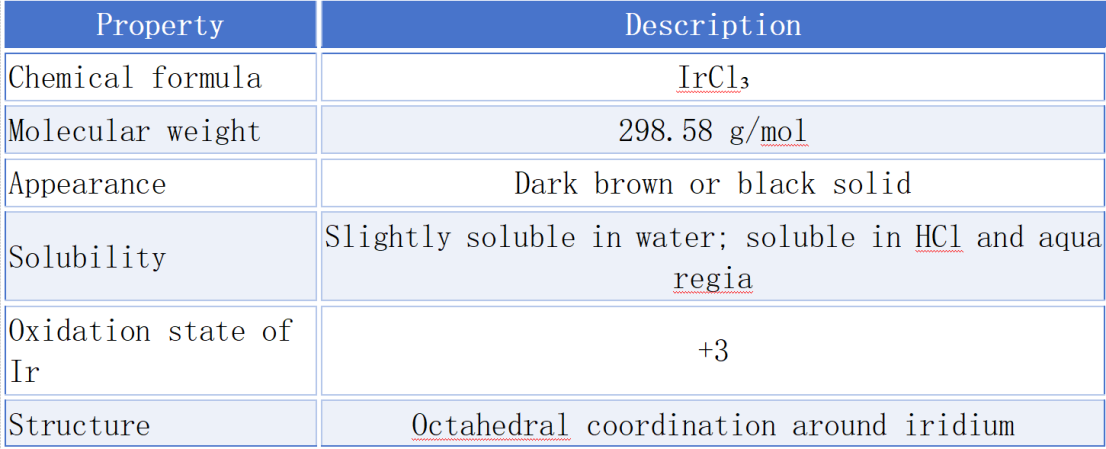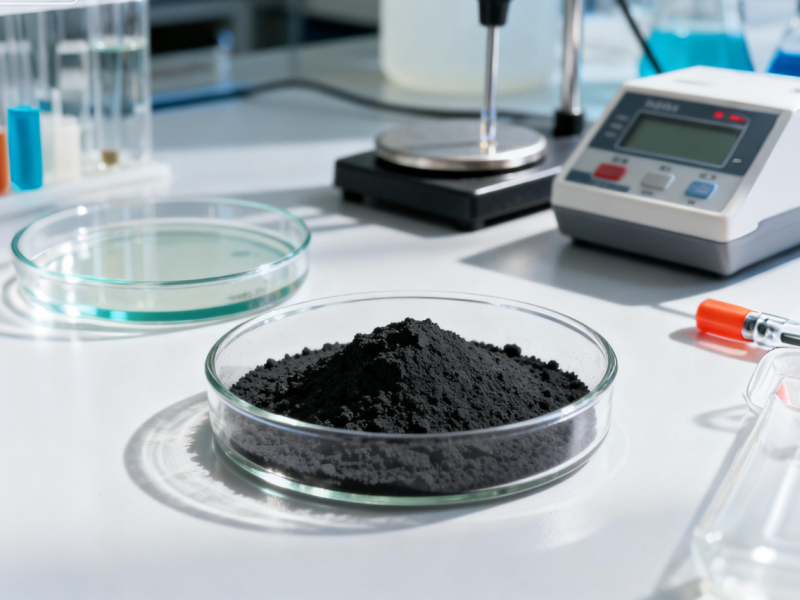Iridium Trichloride(IrCl₃,CAS:10025-83-9), also known as Iridium(III) Chloride or IrCl₃, is a dark brown to black crystalline solid that plays a vital role in inorganic chemistry and catalysis.
It is a highly stable iridium compound known for its ability to form numerous coordination complexes and serve as a key precursor in iridium-based catalysts and materials.
Because of its thermal stability, chemical inertness, and versatile reactivity, Iridium Trichloride is widely used in industrial catalysis, materials science, and electrochemical research.
ChemicaChemical formula IrCl₃
Iridium Trichloride often exists in anhydrous or hydrated forms (IrCl₃·xH₂O). In hydrated forms, iridium is surrounded by a mix of chloride and water ligands, making it highly reactive for complex formation.
Key Applications of Iridium Trichloride
1. Catalyst Precursor
IrCl₃ is one of the most important starting materials for iridium catalysts.
It is used to synthesize coordination complexes such as [IrCl(CO)(PPh₃)₂], which are active in:
Hydrogenation and oxidation reactions
C–H activation processes
Organic synthesis and fine chemical manufacturing
These catalysts are valued for their efficiency, selectivity, and stability in harsh reaction conditions.
2. Materials and Electrochemical Applications
IrCl₃ is used in the preparation of iridium dioxide (IrO₂), a key material in:
Oxygen evolution reaction (OER) catalysts
Electrodes for fuel cells and electrolyzers
Corrosion-resistant coatings for advanced electronics
Its ability to generate highly stable oxide films makes it essential in renewable energy and electronic device fabrication.
3. Research and Advanced Material Development
In scientific research, IrCl₃ is employed to create organometallic and photoluminescent iridium complexes, which are important for:
OLED (Organic Light-Emitting Diode) materials
Sensor technologies
Coordination chemistry studies
Safety and Handling Guidelines
While Iridium Trichloride is relatively stable, it should be handled with care.
Avoid inhalation or ingestion – can cause respiratory or digestive irritation.
Wear gloves, goggles, and protective clothing when handling.
Store in a cool, dry place away from strong acids and moisture.
Dispose of waste according to local environmental regulations.
Why Iridium Trichloride Matters
Iridium compounds, including IrCl₃, represent a cornerstone of modern catalysis and material science. Their high chemical stability and diverse coordination chemistry allow researchers and manufacturers to design catalysts and functional materials that power clean energy, fine chemicals, and next-generation electronics.
Whether used as a catalyst precursor, electrode material source, or research reagent, Iridium Trichloride continues to be an essential compound for innovation in chemistry and technology.
Conclusion
Iridium Trichloride(IrCl₃,CAS:10025-83-9) is much more than a simple inorganic salt—it’s a gateway to advanced iridium-based chemistry.
From industrial catalysis to renewable energy applications, IrCl₃ plays a crucial role in advancing sustainable technologies and high-performance materials.
Ready to Accelerate Your Research?
For technical datasheets, sample requests, or customized catalyst solutions, contact the UIV CHEM technical support team today. Let us help you achieve breakthrough results in organic synthesis and materials innovation!






